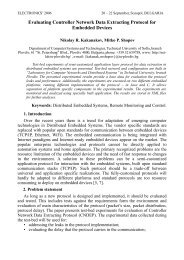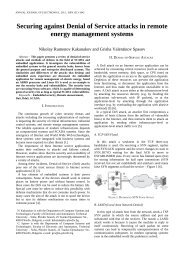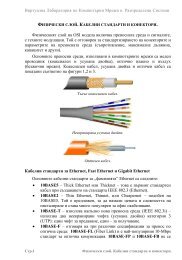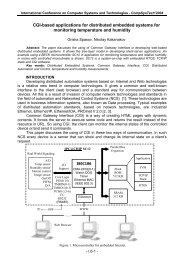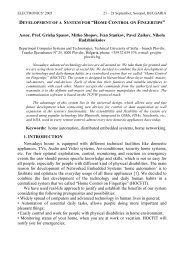SIM300D AT Command Set - Distributed Systems and Networking
SIM300D AT Command Set - Distributed Systems and Networking
SIM300D AT Command Set - Distributed Systems and Networking
Create successful ePaper yourself
Turn your PDF publications into a flip-book with our unique Google optimized e-Paper software.
<strong>SIM300D</strong> <strong>AT</strong> <strong>Comm<strong>and</strong></strong> <strong>Set</strong><br />
Confidential SIMCOM<br />
1.3 Conventions <strong>and</strong> abbreviations<br />
In this document, the GSM engines are referred to as following term:<br />
1) ME (Mobile Equipment);<br />
2) MS (Mobile Station);<br />
3) TA (Terminal Adapter);<br />
4) DCE (Data Communication Equipment) or facsimile DCE(FAX modem, FAX board);<br />
In application, controlling device controls the GSM engine by sending <strong>AT</strong> <strong>Comm<strong>and</strong></strong> via its serial<br />
interface. The controlling device at the other end of the serial line is referred to as following term:<br />
1) TE (Terminal Equipment);<br />
2) DTE (Data Terminal Equipment) or plainly “the application” which is running on an<br />
embedded system;<br />
1.4 <strong>AT</strong> <strong>Comm<strong>and</strong></strong> syntax<br />
The "<strong>AT</strong>" or "at" prefix must be set at the beginning of each comm<strong>and</strong> line. To terminate a<br />
comm<strong>and</strong> line enter .<br />
<strong>Comm<strong>and</strong></strong>s are usually followed by a response that includes.””<br />
Throughout this document, only the responses are presented, are omitted<br />
intentionally.<br />
The <strong>AT</strong> comm<strong>and</strong> set implemented by <strong>SIM300D</strong> is a combination of GSM07.05, GSM07.07 <strong>and</strong><br />
ITU-T recommendation V.25ter <strong>and</strong> the <strong>AT</strong> comm<strong>and</strong>s developed by SIMCOM.<br />
Note: Only enter <strong>AT</strong> comm<strong>and</strong> through serial port after <strong>SIM300D</strong> is power on <strong>and</strong><br />
Unsolicited Result Code “RDY” is received from serial port. And if unsolicited result<br />
code”SCKS: 0” returned it indicates SIM card isn’t present.<br />
All these <strong>AT</strong> comm<strong>and</strong>s can be split into three categories syntactically: “basic”, “S parameter”,<br />
<strong>and</strong> “extended”. These are as follows:<br />
1.4.1 Basic syntax<br />
These <strong>AT</strong> comm<strong>and</strong>s have the format of “<strong>AT</strong>”, or “<strong>AT</strong>&”, where “”is the<br />
comm<strong>and</strong>, <strong>and</strong> “”is/are the argument(s) for that comm<strong>and</strong>. An example of this is “<strong>AT</strong>E”,<br />
which tells the DCE whether received characters should be echoed back to the DTE according to<br />
the value of “”. “” is optional <strong>and</strong> a default will be used if missing.<br />
1.4.2 S parameter syntax<br />
These <strong>AT</strong> comm<strong>and</strong>s have the format of “<strong>AT</strong>S=”, where “” is the index of the S<br />
<strong>SIM300D</strong>_<strong>AT</strong>_V1.00 Page 5 of 180



